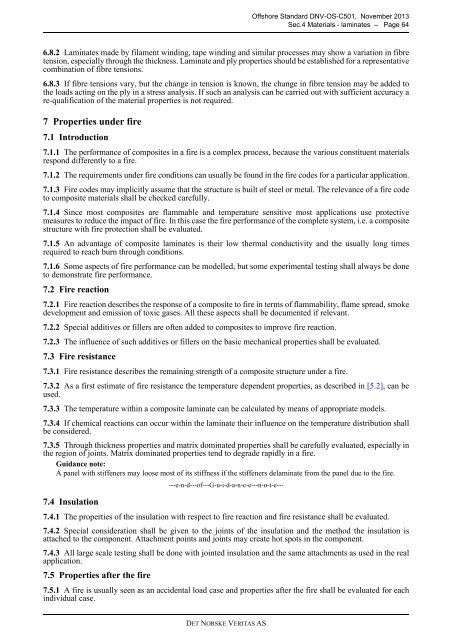OS-C501
You also want an ePaper? Increase the reach of your titles
YUMPU automatically turns print PDFs into web optimized ePapers that Google loves.
Offshore Standard DNV-<strong>OS</strong>-<strong>C501</strong>, November 2013<br />
Sec.4 Materials - laminates – Page 64<br />
6.8.2 Laminates made by filament winding, tape winding and similar processes may show a variation in fibre<br />
tension, especially through the thickness. Laminate and ply properties should be established for a representative<br />
combination of fibre tensions.<br />
6.8.3 If fibre tensions vary, but the change in tension is known, the change in fibre tension may be added to<br />
the loads acting on the ply in a stress analysis. If such an analysis can be carried out with sufficient accuracy a<br />
re-qualification of the material properties is not required.<br />
7 Properties under fire<br />
7.1 Introduction<br />
7.1.1 The performance of composites in a fire is a complex process, because the various constituent materials<br />
respond differently to a fire.<br />
7.1.2 The requirements under fire conditions can usually be found in the fire codes for a particular application.<br />
7.1.3 Fire codes may implicitly assume that the structure is built of steel or metal. The relevance of a fire code<br />
to composite materials shall be checked carefully.<br />
7.1.4 Since most composites are flammable and temperature sensitive most applications use protective<br />
measures to reduce the impact of fire. In this case the fire performance of the complete system, i.e. a composite<br />
structure with fire protection shall be evaluated.<br />
7.1.5 An advantage of composite laminates is their low thermal conductivity and the usually long times<br />
required to reach burn through conditions.<br />
7.1.6 Some aspects of fire performance can be modelled, but some experimental testing shall always be done<br />
to demonstrate fire performance.<br />
7.2 Fire reaction<br />
7.2.1 Fire reaction describes the response of a composite to fire in terms of flammability, flame spread, smoke<br />
development and emission of toxic gases. All these aspects shall be documented if relevant.<br />
7.2.2 Special additives or fillers are often added to composites to improve fire reaction.<br />
7.2.3 The influence of such additives or fillers on the basic mechanical properties shall be evaluated.<br />
7.3 Fire resistance<br />
7.3.1 Fire resistance describes the remaining strength of a composite structure under a fire.<br />
7.3.2 As a first estimate of fire resistance the temperature dependent properties, as described in [5.2], can be<br />
used.<br />
7.3.3 The temperature within a composite laminate can be calculated by means of appropriate models.<br />
7.3.4 If chemical reactions can occur within the laminate their influence on the temperature distribution shall<br />
be considered.<br />
7.3.5 Through thickness properties and matrix dominated properties shall be carefully evaluated, especially in<br />
the region of joints. Matrix dominated properties tend to degrade rapidly in a fire.<br />
Guidance note:<br />
A panel with stiffeners may loose most of its stiffness if the stiffeners delaminate from the panel due to the fire.<br />
7.4 Insulation<br />
---e-n-d---of---G-u-i-d-a-n-c-e---n-o-t-e---<br />
7.4.1 The properties of the insulation with respect to fire reaction and fire resistance shall be evaluated.<br />
7.4.2 Special consideration shall be given to the joints of the insulation and the method the insulation is<br />
attached to the component. Attachment points and joints may create hot spots in the component.<br />
7.4.3 All large scale testing shall be done with jointed insulation and the same attachments as used in the real<br />
application.<br />
7.5 Properties after the fire<br />
7.5.1 A fire is usually seen as an accidental load case and properties after the fire shall be evaluated for each<br />
individual case.<br />
DET NORSKE VERITAS AS



